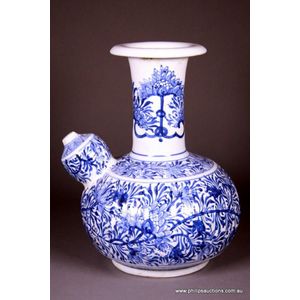Kangxi Blue and White Shipwreck Kendi
You must be a subscriber, and be logged in to view price and dealer details.
Subscribe Now to view actual auction price for this item
When you subscribe, you have the option of setting the currency in which to display prices to $Au, $US, $NZ or Stg.
- Ming Dynasty - The Ming Dynasty was a ruling dynasty of China from 1368 to 1644. It succeeded the Yuan Dynasty and preceded the Qing Dynasty. The Ming Dynasty was established by Zhu Yuanzhang, a former Buddhist monk who became a rebel leader and eventually overthrew the Mongol Yuan Dynasty. During the Ming Dynasty, China experienced a period of relative stability and prosperity. The government was centralized and bureaucratic, with the emperor at the top of the hierarchy. The Ming Dynasty is known for its cultural achievements, including the development of porcelain, the invention of movable type printing, and the construction of the Great Wall of China.
- Foliate - Decorated with leaves or leaf-like forms.
- Manner of .... / Style of ..... - A cataloguing term where the item, in the opinion of the cataloguer is a work in the style of the artist, craftsman or designer, possibly of a later period.
- Qing Dynasty - The Qing Dynasty was the last imperial dynasty of China, ruling from 1644 to 1912. It was established by the Manchu people, who originated from the northeastern region of China. The Qing Dynasty was preceded by the Ming Dynasty and followed by the Republic of China.
- Circa - A Latin term meaning 'about', often used in the antique trade to give an approximate date for the piece, usually considered to be five years on either side of the circa year. Thus, circa 1900 means the piece was made about 1900, probably between 1895 and 1905. The expression is sometimes abbreviated to c.1900.
This item has been included into following indexes:
- Chinese ceramics, decoration - blue and white, other 760
- Chinese ceramics, dynasty mark or period
- Chinese ceramics, shipwreck cargo
- oriental objects - kendi (pouring vessels) 50
Visually similar items

A Chinese two piece vase. A decoratively pierced ovoid vase with scrollwork and flowers throughout in colours upon a cream ground, and having a removal columnar piece, the lappet decorated and floral bordered collar and trumpet neck serving as the top of t

A Chinese blue and white Yen Yen vase, the body and neck bearing continuous scenes of scholars and others in landscape and pavilion settings, with key fret and chevron patterns to the collar; bearing concentric rings underside. Height 39.5 cm

A Chinese porcelain vase with incised decoration under the celadon glaze, height 22 cm

A Chinese porcelain baluster shaped vase, an iron red Xianfeng mark, finely painted with a viallage below the mountains, a poem on reverse, height 41 cm
